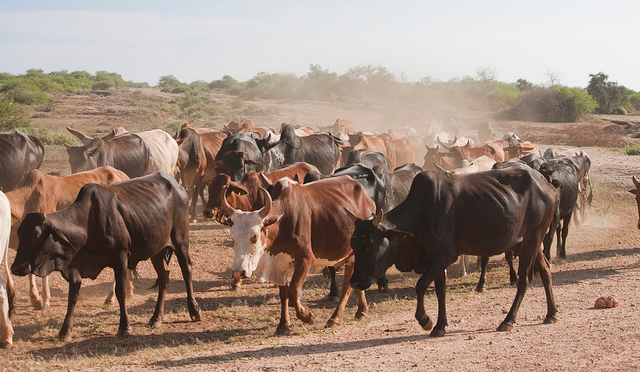Livestock Grazing
Livestock grazing, also known as pastoralism, has been practiced in Africa for many thousands of years. Nomadic herding cultures existed throughout the continent long before the arrival of Europeans. As colonial governments seized land for agriculture and industry, many pastoral societies were forced to abandon or modify their traditional lifestyles. Nevertheless, some African peoples still depend on herding for their livelihood.
Types of Pastoralism
There are two types of African cultures based on livestock grazing: cattle societies and camel societies. Cattle societies are spread across the savanna regions of northwestern, eastern, and southern Africa. Camel societies live mostly in the continent's northern and eastern deserts. Herding peoples have historically avoided central Africa, where the tsetse fly is found. Tsetse flies often carry sleeping sickness, which can be deadly to humans and large animals.

Cattle societies place a high value on the ownership of cattle. Individuals who control the largest herds have the most power and prestige. Because cattle do not provide for all of the community's needs, pastoral groups often combine livestock raising with gathering foods that grow wild or farming. They also enter into exchange relationships with agricultural societies, trading meat, milk, and hides for grains, fruits, and vegetables. These economic relations sometimes develop into political ties. In the past the FULANI, a herding people of western and central Africa, had trading relations with farming communities. Fulani leaders later formed states that included the groups in their trading networks.
Camel societies, organized around the use of camels as pack animals, are a relatively recent development. Groups such as the BERBERS of North Africa began using camels to transport goods across the SAHARA DESERT several hundred years ago. Like cattle societies, camel herders rely on exchange with farming peoples to obtain plant foods. They often work as traders, acquiring goods from various groups and distributing them in distant regions.
History of African Pastoralism
Animal bones found in the northern Sahara suggest that people were raising livestock thousands of years
before farming took place. The earliest herders kept sheep and goats, but after about 4000 B.C. people began to raise cattle. At that time the Saharan climate was much cooler and moister than it is today, with extensive woods and grasslands.
African rock paintings show scenes of people tending herds of cattle and sheep. Beginning about 2500 B.C., a change in climate caused the Sahara to dry up. Overgrazing—allowing large herds of animals to feed on the land until the surface vegetation is destroyed—may have accelerated the process. The climate change forced pastoralists to move farther south.
In East Africa, cattle raising was firmly established by 2000 B.C. Sheepherding societies flourished in southern Africa during the last centuries B.C. These animals may have come from East Africa or they may have been introduced into the region by BANTU-speaking peoples migrating from west-central Africa.
Colonialism and its aftermath have greatly affected the lives of African pastoralists. The open ranges where they traditionally grazed their herds were fenced in, and their movements were restricted by new political borders. Agriculture and industry damaged some of the grasslands that once supported livestock. In many cases herding peoples whose livelihood was threatened participated in political movements protesting the changes.
Social relations in many livestock-based societies have also altered over the years. People who once measured wealth in animals now measure it in terms of money. Nevertheless, pastoralism is still an important part of the economies of many African countries. (See also Animals, Domestic; Colonialism in Africa; Diseases; Economic History; Ecosystems.)